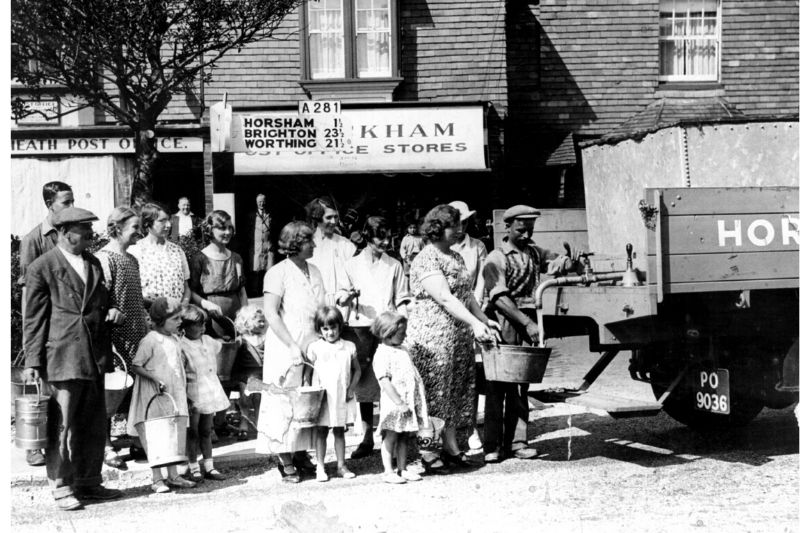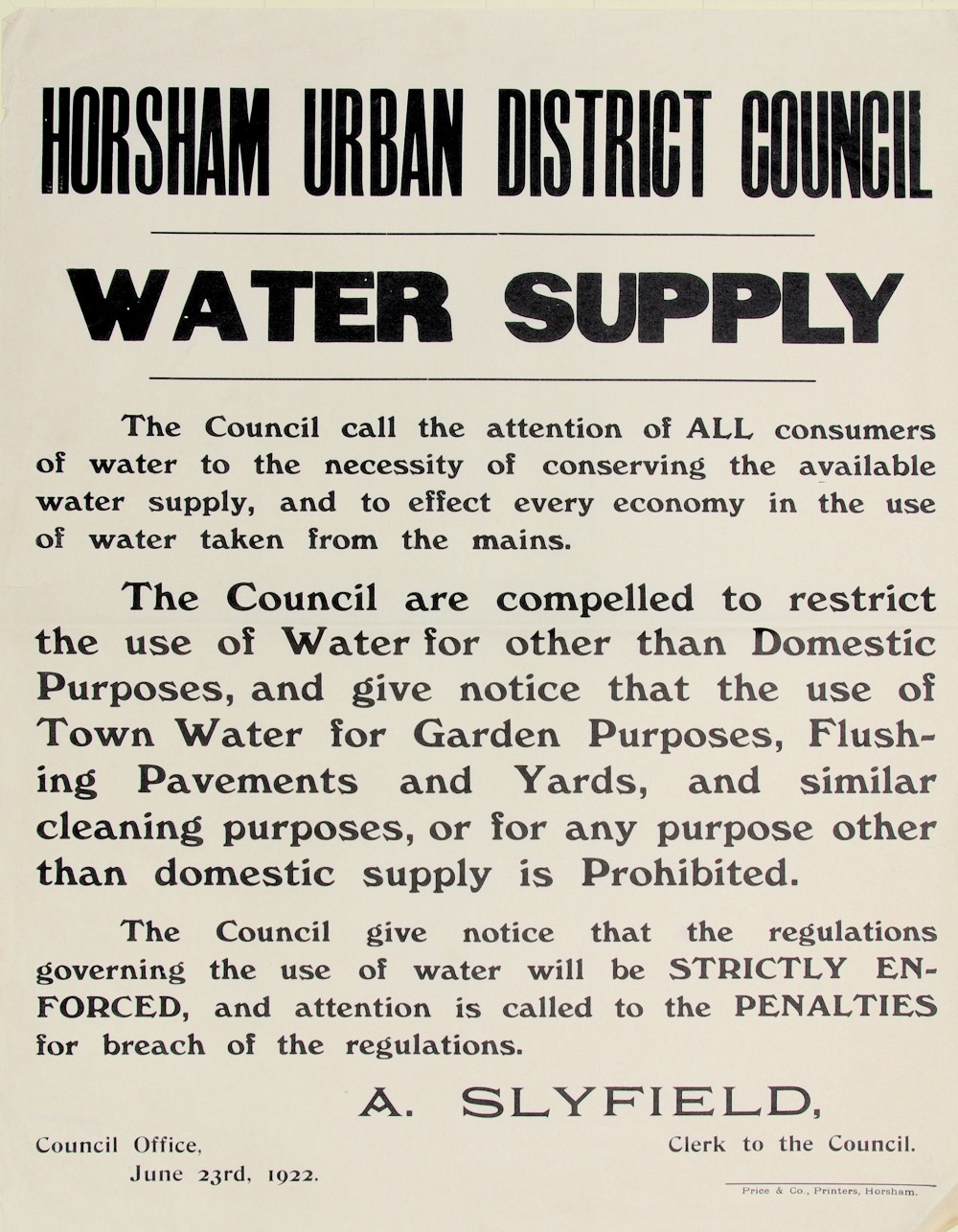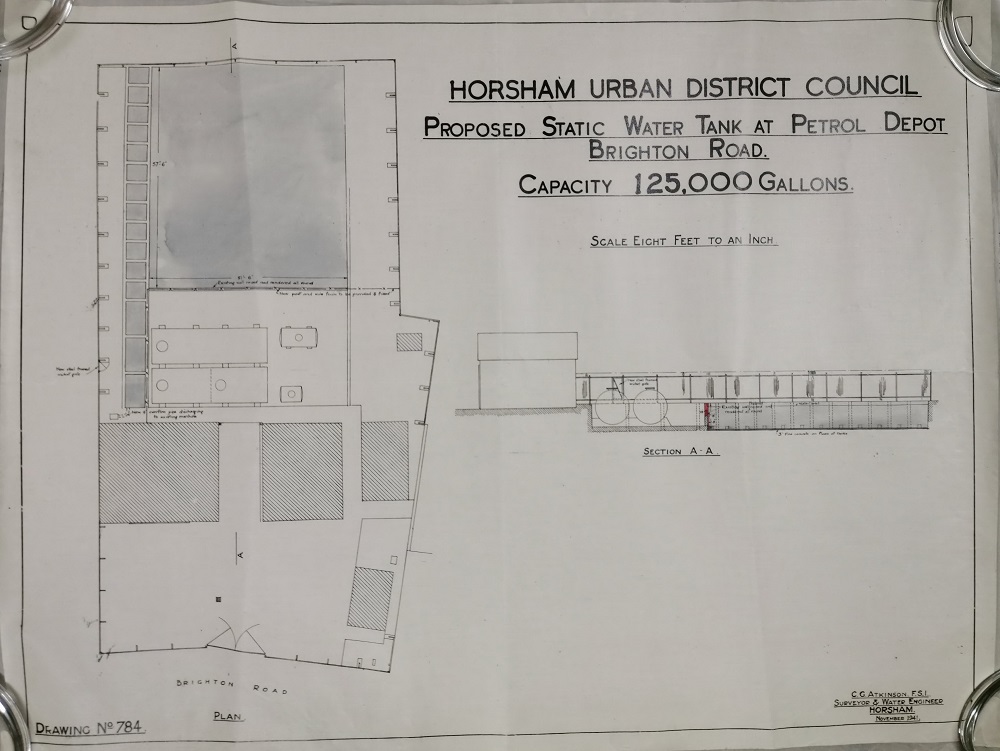
A look at the provision of water in Horsham District in the 20th century.
New Century, Old Problems
One of the most unusual notices put out by Horsham Rural District Council was a November 1919 invitation to tender for
“divining for water and sinking wells upon 28 sites selected for building dwellings for the working classes scattered throughout the Parishes of Billingshurst, Cowfold, Horsham Rural, Ifield, Itchingfield, Lower Beeding, Nuthurst, Rusper, Shipley, Slinfold, Warnham and West Grinstead.”
In Horsham the water supply for Council housing was drawn from the town’s supply and not from localised wells. Whilst it might seem very old fashioned, in reality 30 years earlier Horsham Council would have had to place the same sort of advertisement, as its supply wasn’t that extensive.
Sanitary
Although the Government and the nation were in retrenchment following the First World War and the Spanish Flu pandemic, the Urban District Council still chose to implement a major improvement in the quality of life for most of its residents; the enforcement of sanitation.
The Council’s Sanitary Inspector undertook a street by street survey of sanitation in the town and in June 1922 he reported the below:
- Number of houses without flushing tanks ……………….830
- Requiring separate closets ……………………………………….58
- With earth closets …………………………………………………….26
- With privies ………………………………………………………………22
The District Councillors agreed that all properties should have flushing tanks, and all earth closets should be removed and replaced with proper flushing systems. The house owners or landlords were given one year to get the work done. The one drawback was that the town was also suffering from periods of poor water supply. In 1922 the town converted its steam driven water pumps to electricity, unfortunately however, the water problem would continue throughout the 1920s and beyond. The expanding the use of water closets, whilst desirable, had a distinct effect on water supply.
In 1925 the situation was very severe, as a booklet published in 1932 explained:
“By this time it was evident that a new supply of water was a necessity owing to continued growth of Horsham, the increase in the amount of water used and to the falling-off in the flow of water to the wells…At the same time, owing to various technical difficulties, the amount of water stored in the Star Reservoir (it had been constructed in 1877 (actually 1883) near the Star Inn on the Crawley road) …was reduced from 500,000 gallons to only 78,000 gallons. There was no filtration or purification of this water, it being delivered to the consumers exactly as received in the wells, and iron in suspension in the water was a source of much complaint.”
In May of that year a request to supply water for swimming baths at the new Manor House School caused some discussion in the Council. In 1926 it was reported that the test boring for water at Whites Bridge yielded 20,300 gallons per hour. It was hoped that this would help solve Horsham’s water shortage, however there would be shortages for some time as shown in a 1928 newspaper account:
“Since the last meeting the yield of water had decreased by 1,200 gallons per hour, and in spite of notices having been sent out asking consumers to curtail the use of water as much as possible the consumption had increased by 25 per cent.”
Just to reinforce the issue the local paper carried a notice by HUDC informing residents that, on Monday 23rd from 6pm to 6am, a number of roads would be without water. In all 37 roads, or part of roads, are listed.

The 1930s
The greatest commitment to the future of the town wasn’t the restructuring of the schools, or the investment in the market, both of which are symbolic and important, but the creation of a new sewage and waterworks that would provide fresh water for 30 or more years. Or so the planners predicted.
The first development was the provision of a constant supply of fresh clean drinking water. It had taken two years of investigation, and the previous decade of water shortages, to come up with a solution. The solution was dramatic, extensive and expensive at a time when austerity was in the air, although not yet the watchword. The Council wanted to borrow £60,791 in order to provide water “for the town until 1960 at least”, as well as hopefully supplying the surrounding villages. The scheme would consist of two boreholes at White’s Bridge, as well as the necessary plant and mains, and a reservoir with a capacity for 1,600,000 gallons.
The Council’s decision to require flushing toilets also put increased demands on the water supply. In 1894, with a population of 8,500, around 50,000,000 gallons were pumped, while in 1929 with a population of 12,500, around 94,500,000 gallons were pumped. The Council’s new sewage scheme ran in a circle around the town consisting of 7.5 miles of concrete pipes which relied on gravity rather than pumping. At the start of 1931 there was an announcement for water pipes, and at the end of the year there was another for sewage pipes. Both required significant additional employment and were unlikely to have happened without the grants.

In 1932 The County Times carried a fascinating if slightly breathless account of the construction of both the water and sewage pipe work describing how:
“A small mining community is established in the field between the disposal works and Guilford road. Down the shafts welsh miners struggle to cut out the wet clay to form a tunnel through which the sewer can run. Shafts are sunk 50 feet apart so that miners in each one have to excavate a 25 foot tunnel in order to meet their comrades in the next shaft. Further along the field where the ground falls, it is possible to lay the sewer in an open trench. “Let’s go down this one,” says Mr. Atkinson, pointing to the most formidable shaft. …I follow him down a ladder by the side of the shaft having first politely refused an invitation to descend in a swaying bucket…Down below, standing in slush; we crouch in the tunnel while the roof dribbles on our backs. Across the way, in the flickering light of a candle, is a miner beating the merry tattoo of the road mender with a compressed drill as he carves out the clay….The work of sewer laying began last December, and it will keep gangs at four different points busy for two years…About ninety men (half of whom come from distressed areas) are engaged in this scheme.”
In April 1933 the Water Committee issued handbills and placed adverts in newspapers stating that the new water scheme would start on 4th May 1933. On 5th May the County Times lead with the news that:
“Horsham’s Water Fears Now Banished… Fears of a water shortage that have beset Horsham for the last few summers will be finally banished by the new supply system which was brought in to operation yesterday. In addition to certainty and purity of supply the scheme will result in the pressure of water being doubled. This is caused by the force of gravity, the reservoir being about 300 feet higher than the old pumping station.”
Published: 26 Jun 2020
